Abstract
In a previous study we have shown that an isometric handgrip is accompanied by a rapid decrease in vascular resistance in the resting (contralateral) forearm, lasting for about 1 min, which in all probability is neurogenic. 2. In the present study the distribution of the vasodilatation was investigated by analysing O2 saturation in a deep vein, draining mainly muscle tissue. Some possible neurogenic mechanisms for the vasodilatation were tested by repeating the handgrip after local beta- and alpha-adrenergic blockade of the resting forearm with propranolol and phentolamine, respectively. 3. Without blockades the forearm vascular resistance decreased and the deep vein O2 saturation increase to similar degrees on contralateral handgrip. Propranolol markedly reduced both the decrease in resistance and the increase in deep vein O2 saturation. Phentolamine did not alter the initial decrease in resistance, but with phentolamine resistance continued to decrease after 1 min. 4. It is concluded that the rapid decrease in vascular resistance in the resting forearm on contralateral handgrip takes place, to a great extent, in muscle. It is mediated by neurogenic beta-adrenergic mechanisms and if the contraction is prolonged it gradually changes to a vasoconstriction mediated by alpha-adrenergic mechanisms.
Full text
PDF
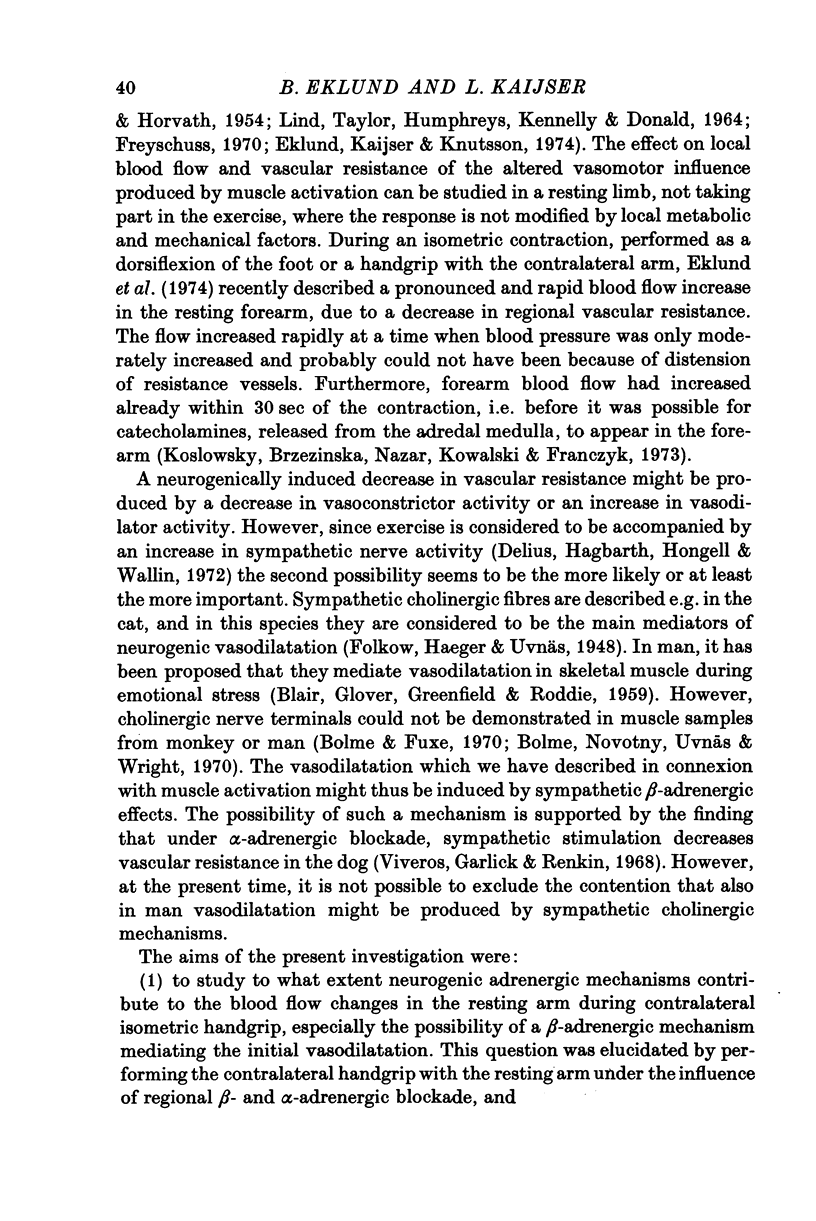

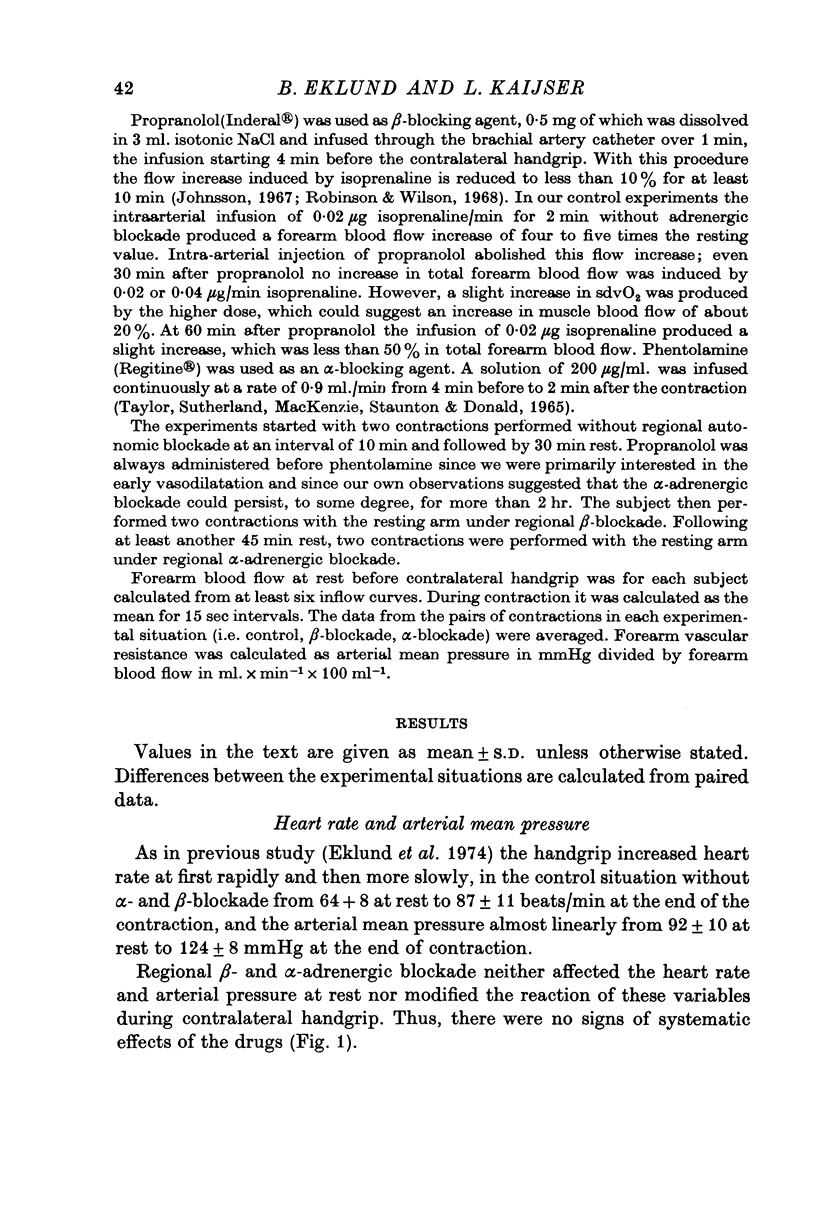
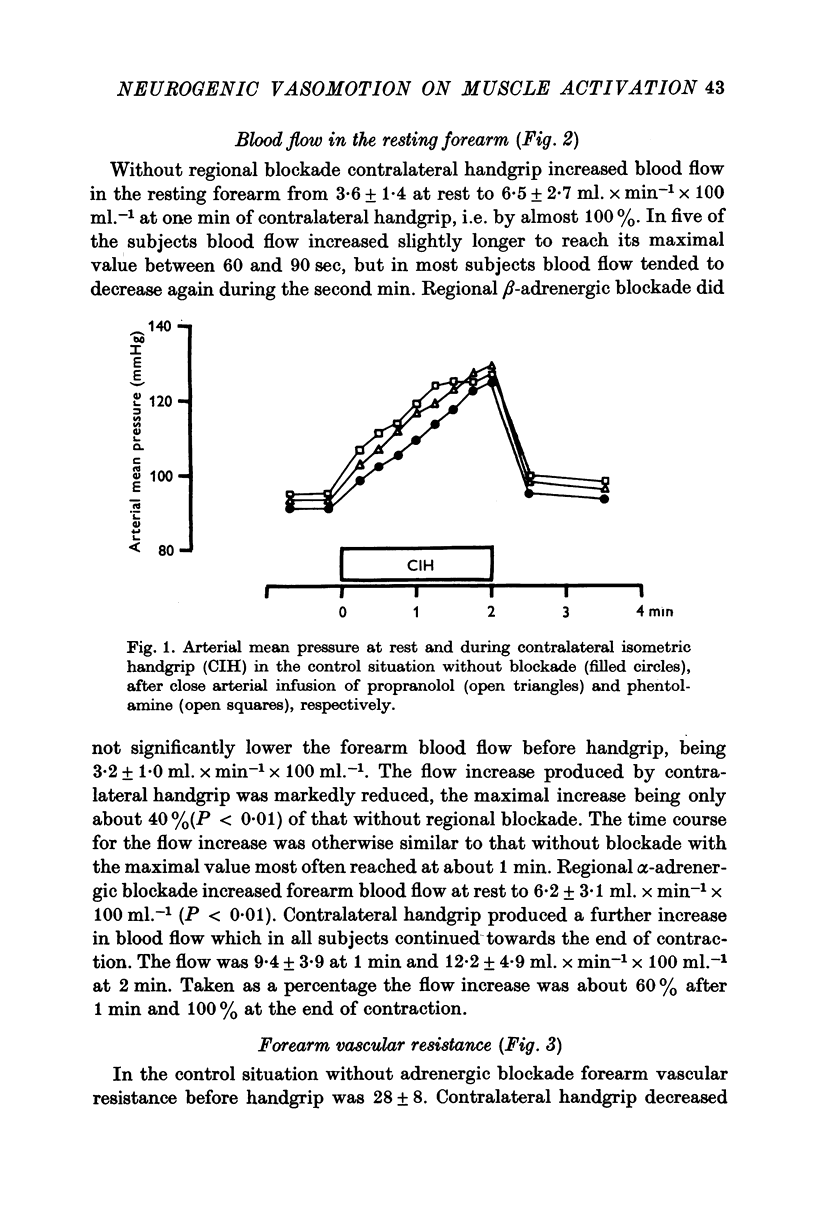
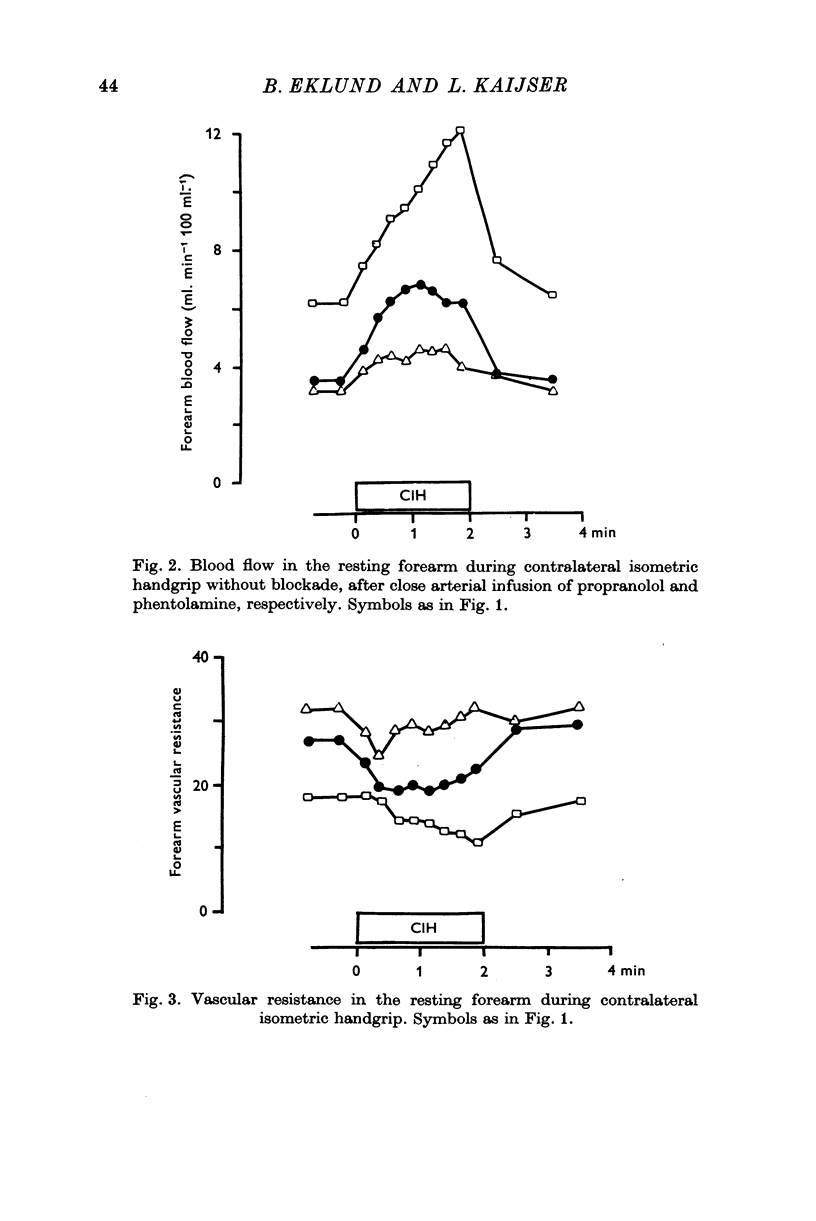

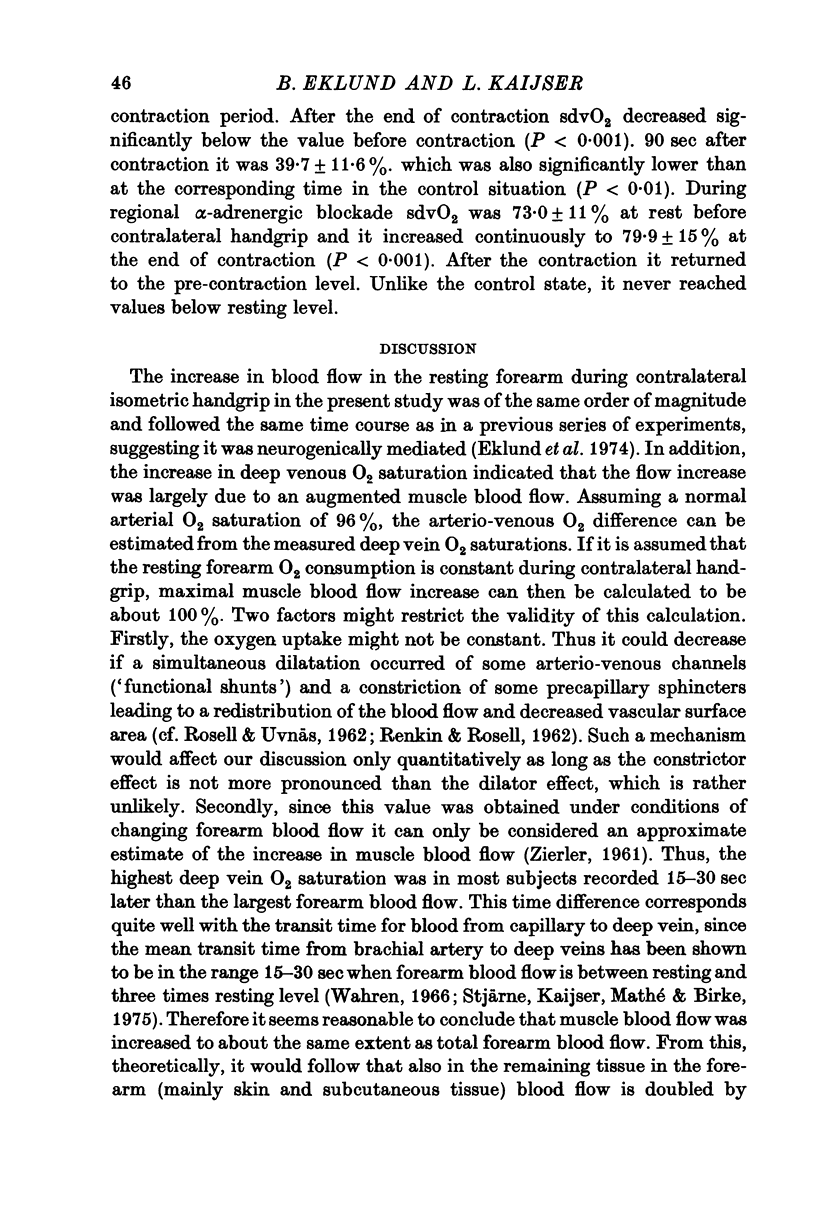



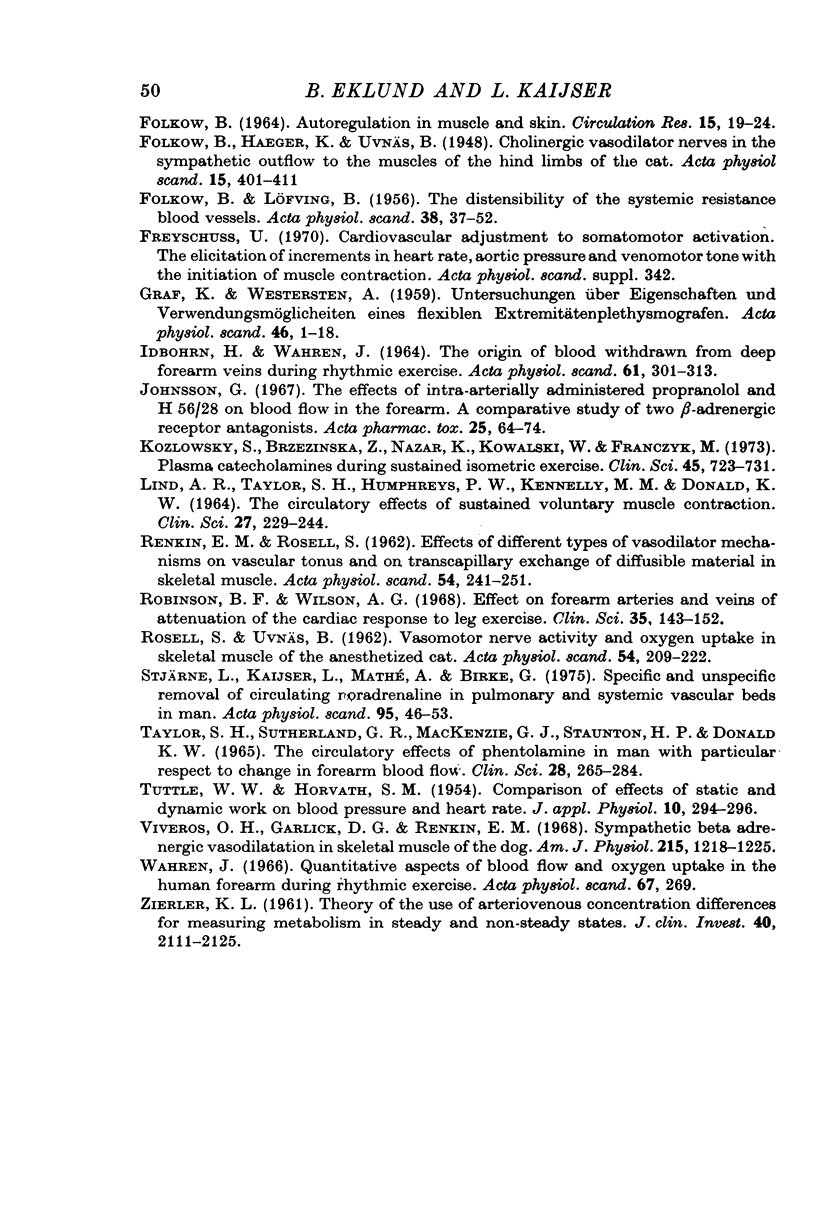
Selected References
These references are in PubMed. This may not be the complete list of references from this article.
- BLAIR D. A., GLOVER W. E., GREENFIELD A. D., RODDIE I. C. Excitation of cholinergic vasodilator nerves to human skeletal muscles during emotional stress. J Physiol. 1959 Oct;148:633–647. doi: 10.1113/jphysiol.1959.sp006312. [DOI] [PMC free article] [PubMed] [Google Scholar]
- Bolme P., Fuxe K. Adrenergic and cholinergic nerve terminals in skeletal muscle vessels. Acta Physiol Scand. 1970 Jan;78(1):52–59. doi: 10.1111/j.1748-1716.1970.tb04638.x. [DOI] [PubMed] [Google Scholar]
- Bolme P., Novotný J., Uvnäs B., Wright P. G. Species distribution of sympathetic cholinergic vasodilator nerves in skeletal muscle. Acta Physiol Scand. 1970 Jan;78(1):60–64. doi: 10.1111/j.1748-1716.1970.tb04639.x. [DOI] [PubMed] [Google Scholar]
- Brungardt J. M., Swan K. G., Reynolds D. G. Adrenergic mechanisms in canine hindlimb circulation. Cardiovasc Res. 1974 May;8(3):423–429. doi: 10.1093/cvr/8.3.423. [DOI] [PubMed] [Google Scholar]
- CLARKE R. S., HELLON R. F., LIND A. R. The duration of sustained contractions of the human forearm at different muscle temperatures. J Physiol. 1958 Oct 31;143(3):454–473. doi: 10.1113/jphysiol.1958.sp006071. [DOI] [PMC free article] [PubMed] [Google Scholar]
- COLES D. R., COOPER K. E., MOTTRAM R. F., OCCLESHAW J. V. The source of blood samples withdrawn from deep forearm veins via catheters passed upstream from the median cubital vein. J Physiol. 1958 Jul 14;142(2):323–328. doi: 10.1113/jphysiol.1958.sp006019. [DOI] [PMC free article] [PubMed] [Google Scholar]
- COOPER K. E., EDHOLM O. G., MOTTRAM R. F. The blood flow in skin and muscle of the human forearm. J Physiol. 1955 May 27;128(2):258–267. doi: 10.1113/jphysiol.1955.sp005304. [DOI] [PMC free article] [PubMed] [Google Scholar]
- Delius W., Hagbarth K. E., Hongell A., Wallin B. G. Manoeuvres affecting sympathetic outflow in human muscle nerves. Acta Physiol Scand. 1972 Jan;84(1):82–94. doi: 10.1111/j.1748-1716.1972.tb05157.x. [DOI] [PubMed] [Google Scholar]
- Eklund B., Kaijser L., Knutsson E. Blood flow in resting (contralateral) arm and leg during isometric contraction. J Physiol. 1974 Jul;240(1):111–124. doi: 10.1113/jphysiol.1974.sp010602. [DOI] [PMC free article] [PubMed] [Google Scholar]
- FOLKOW B. AUTOREGULATION IN MUSCLE AND SKIN. Circ Res. 1964 Aug;15:SUPPL–SUPPL:24. [PubMed] [Google Scholar]
- FOLKOW B., LOFVING B. The distensibility of the systemic resistance blood vessels. Acta Physiol Scand. 1956 Dec 29;38(1):37–52. doi: 10.1111/j.1748-1716.1957.tb00172.x. [DOI] [PubMed] [Google Scholar]
- IDBOHRN H., WAHREN J. THE ORIGIN OF BLOOD WITHDRAWN FROM DEEP FOREARM VEINS DURING RHYTHMIC EXERCISE. Acta Physiol Scand. 1964 Aug;61:301–313. [PubMed] [Google Scholar]
- Kozlowski S., Brzezinska Z., Nazar K., Kowalski W., Franczyk M. Plasma catecholamines during sustained isometric exercise. Clin Sci Mol Med. 1973 Dec;45(6):723–731. doi: 10.1042/cs0450723. [DOI] [PubMed] [Google Scholar]
- LIND A. R., TAYLOR S. H., HUMPHREYS P. W., KENNELLY B. M., DONALD K. W. THE CIRCULATIORY EFFECTS OF SUSTAINED VOLUNTARY MUSCLE CONTRACTION. Clin Sci. 1964 Oct;27:229–244. [PubMed] [Google Scholar]
- RENKIN E. M., ROSELL S. Effects of different types of vasodilator mechanisms on vascular tonus and on transcapillary exchange of diffusible material in skeletal muscle. Acta Physiol Scand. 1962 Mar-Apr;54:241–251. doi: 10.1111/j.1748-1716.1962.tb02349.x. [DOI] [PubMed] [Google Scholar]
- ROSELL S., UVNAS B. Vasomotor nerve activity and oxygen uptake in skeletal muscle of the anesthetized cat. Acta Physiol Scand. 1962 Mar-Apr;54:209–222. doi: 10.1111/j.1748-1716.1962.tb02347.x. [DOI] [PubMed] [Google Scholar]
- Robinson B. F., Wilson A. G. Effect on forearm arteries and veins of attenuation of the cardiac response to leg exercise. Clin Sci. 1968 Aug;35(1):143–152. [PubMed] [Google Scholar]
- Stjärne L., Kaijser L., Mathé A., Birke G. Specific and unspecific removal of circulating noradrenaline in pulmonary and systemic vascular beds in man. Acta Physiol Scand. 1975 Sep;95(1):46–53. doi: 10.1111/j.1748-1716.1975.tb10023.x. [DOI] [PubMed] [Google Scholar]
- TAYLOR S. H., SUTHERLAND G. R., MACKENZIE G. J., STAUNTON H. P., DONALD K. W. THE CIRCULATORY EFFECTS OF PHENTOLAMINE IN MAN WITH PARTICULAR RESPECT TO CHANGES IN FOREARM BLOOD FLOW. Clin Sci. 1965 Apr;28:265–284. [PubMed] [Google Scholar]
- TUTTLE W. W., HORVATH S. M. Comparison of effects of static and dynamic work on blood pressure and heart rate. J Appl Physiol. 1957 Mar;10(2):294–296. doi: 10.1152/jappl.1957.10.2.294. [DOI] [PubMed] [Google Scholar]
- Viveros O. H., Garlick D. G., Renkin E. M. Sympathetic beta adrenergic vasodilatation in skeletal muscle of the dog. Am J Physiol. 1968 Nov;215(5):1218–1225. doi: 10.1152/ajplegacy.1968.215.5.1218. [DOI] [PubMed] [Google Scholar]
- Zierler K. L. THEORY OF THE USE OF ARTERIOVENOUS CONCENTRATION DIFFERENCES FOR MEASURING METABOLISM IN STEADY AND NON-STEADY STATES. J Clin Invest. 1961 Dec;40(12):2111–2125. doi: 10.1172/JCI104437. [DOI] [PMC free article] [PubMed] [Google Scholar]


